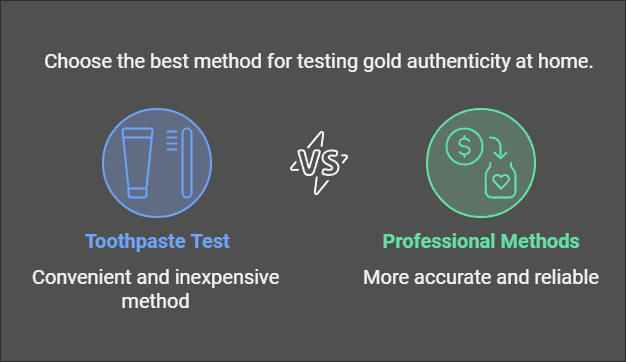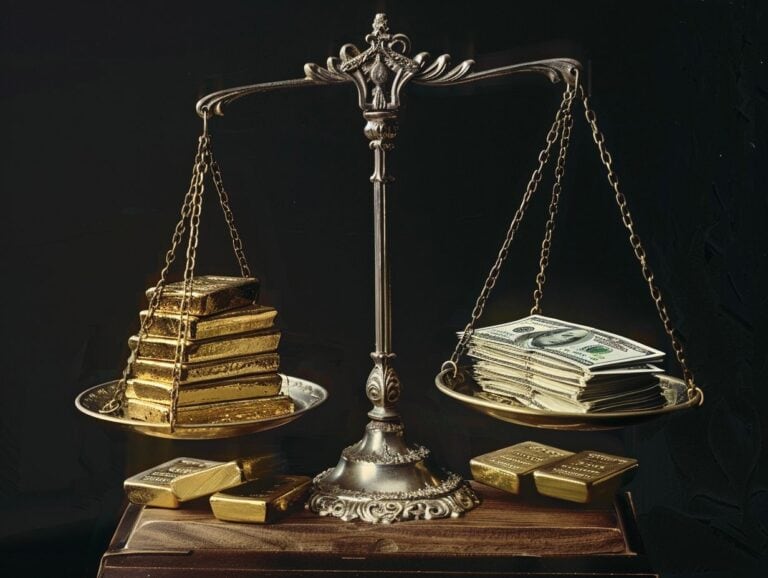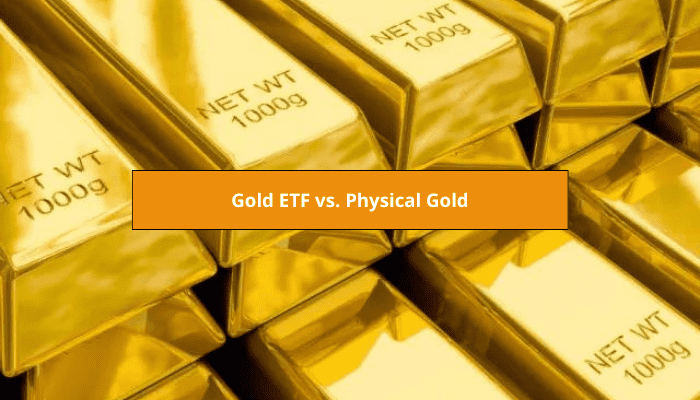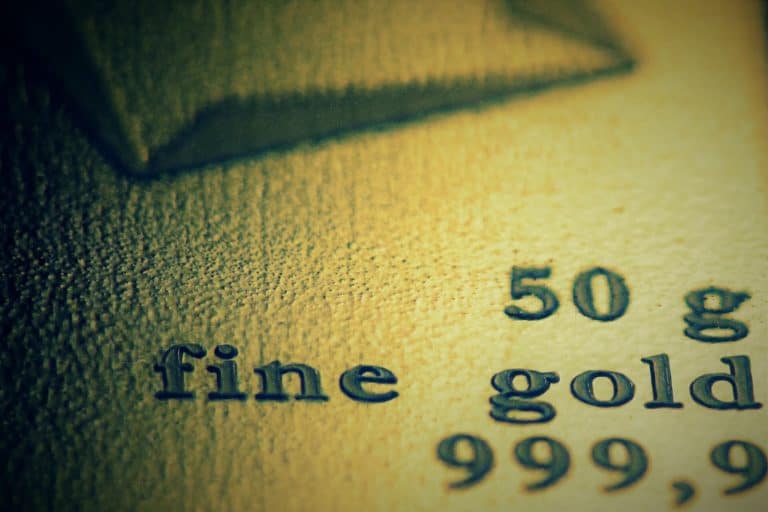Testing gold at home with toothpaste is a simple and affordable method to assess the authenticity of your gold items. This gold testing technique leverages the abrasive properties of toothpaste to help identify whether a piece is genuine gold, gold-plated, or made from lesser quality alloys.
To perform this test, you’ll need a small amount of toothpaste, the gold item, and a glass of water. By gently applying toothpaste to the gold and observing any discoloration, you can gain insights into its purity. Genuine gold typically retains its color, while a change might indicate impurities or plating.
While toothpaste testing is convenient, it’s important to note its limitations in accuracy compared to professional methods like the nitric acid test and the gold density test. Ensure minimal damage by using non-abrasive toothpaste and a soft cloth, and always thoroughly rinse the gold afterward.
For a more comprehensive verification, consider combining this approach with other at-home methods such as the magnet test, vinegar test, or even consulting a certified jeweler.

Key Takeaways:
- Toothpaste gold testing is a convenient and inexpensive method for testing gold at home, offering a simple guide to determine gold authenticity.
- This method involves rubbing toothpaste on a gold item and observing the color change.
- Other methods for testing gold at home include the magnet, vinegar, and nitric acid tests.
What Is Toothpaste Gold Testing?
Toothpaste gold testing uses toothpaste’s abrasive particles to check gold authenticity by rubbing it on gold jewelry to reveal metal purity.
This method can indicate if an item is genuine gold, gold-plated, or made of lower-quality gold alloys, helping with gold inspection.
What Are the Materials Needed for Toothpaste Gold Testing?
Materials needed for toothpaste gold testing include:
- Toothpaste
- The gold item
- A glass of water
- Optionally, a gold testing kit
1. Toothpaste
Toothpaste is a paste or gel used with a toothbrush to clean and maintain the aesthetics and health of teeth.
Toothpaste contains abrasive particles that help remove dental plaque and food from the teeth, which can also be used in gold inspection.
Some types of toothpaste, such as whitening or tartar-control, contain higher levels of abrasives that can also be used in unconventional gold testing methods to reveal the presence of base metals, ensuring gold is not a plated or alloyed item.
2. Gold Items
Gold items, such as jewelry, rings, and coins, are evaluated for purity based on their karat level, which is crucial for determining gold value and gold investments.
Karat purity indicates gold content, with 24-karat being 99.9% pure gold and 18-karat containing 75% gold.
Gold purity assessment involves checking hallmarks, weight variations, and conducting a visual inspection to ensure the gold is not compromised.
The toothpaste method may help determine gold authenticity.
3. Glass of Water
A glass of water is used in toothpaste gold testing to rinse the gold item after applying toothpaste, ensuring all residue is removed for accurate results.
Rinsing with water prevents toothpaste residue from affecting the test outcome.
How To Test Gold at Home With Toothpaste?
To test gold at home with toothpaste, follow these steps:
- Apply a small amount of white toothpaste to a cotton swab.
- Rub the toothpaste onto the gold piece gently.
- Rinse off the toothpaste with water.
- Observe the gold for any color change; genuine gold should not tarnish or change color.
Toothpaste testing helps identify if the item is gold or gold-plated.
1. Rub the Gold Item on the Toothpaste
To test gold with toothpaste, rub the gold item gently on the toothpaste surface to observe any discoloration.
Minimal discoloration indicates pure gold, while significant tarnishing suggests lower gold purity or other metals present.
2. Observe the Color Change
Observing the color change when testing gold with toothpaste helps determine authenticity.
Genuine gold retains its yellow hue, while a greenish tint suggests copper presence, indicating a non-authentic piece.
Gold turning black or gray signifies impurity as real gold does not tarnish.
This method offers a quick authenticity check without laboratory tests.
3. Rinse the Gold Item and Toothpaste
Rinse the gold item with water to remove toothpaste residue.
Ensure thorough rinsing to prevent residue from affecting the test results.
Proper rinsing reveals the true color and luster of the gold item.
What Are the Other Methods for Testing Gold at Home?
Other methods for testing gold at home include the magnet test, where gold is checked for non-magnetic properties, the vinegar test, where gold is immersed in vinegar to see if it changes color, and the nitric acid test, where a small drop of acid is applied to observe any reaction.
These methods help verify gold authenticity and purity without professional equipment.
1. Magnet Test
Magnet Test checks gold authenticity by determining if the item is magnetic.
Real gold is not magnetic and will not be attracted to a magnet.
If an item is attracted to a magnet, it likely contains ferrous metals and is not pure gold, as genuine gold is not magnetic.
Limitations include non-magnetic materials mimicking gold and some high-karat gold alloys not reacting.
Magnet Test is a preliminary check, not a definitive method for gold authenticity.
2. Vinegar Test
The vinegar test for gold involves applying white vinegar to the item to check for authenticity.
Genuine gold remains unchanged when vinegar is applied, while fake gold discolors or corrodes.
Apply vinegar directly to the gold; no color change indicates authenticity.
3. Nitric Acid Test
The nitric acid test is used to determine gold authenticity by applying nitric acid to the item. Genuine gold does not react, while fake gold or lower karat alloys show discoloration, indicating gold is not pure.
The test involves placing a drop of acid on a discreet area of the gold item to check for reactions indicating base metals.
What Are the Advantages and Disadvantages of Toothpaste Gold Testing?
Toothpaste gold testing has advantages and disadvantages.
Advantages of toothpaste gold testing include ease of use and convenience, as it allows for home testing without specialized equipment.
Disadvantages of toothpaste gold testing include lower accuracy and reliability compared to formal methods such as the acid test and density test.
Advantages:
Toothpaste gold testing offers advantages like ease of use, convenience, affordability, and safety for verifying gold items, making it accessible for gold jewelry care.
Individuals can apply toothpaste to gold and observe reactions to assess authenticity without expensive equipment.
This method avoids harsh chemicals and complex procedures, appealing to non-experts for verifying gold at home.
1. Easy and Convenient
Toothpaste gold testing is a simple method to test the authenticity of gold at home using household items.
- Apply a small amount of toothpaste on the gold item.
- Rub gently.
- Rinse with water.
If the gold item remains unchanged, it is likely genuine gold.
2. Inexpensive
Toothpaste is an inexpensive method for gold testing, avoiding the need for costly testing kits or professional services.
This method allows individuals to test gold at home, saving both money and time.
Using toothpaste reduces the financial barrier for determining gold authenticity.
3. Safe
Toothpaste testing is a safe method for verifying gold authenticity as it uses a gentle, common household item without harsh chemicals, unlike the acid test or other gold testing methods.
This non-invasive test minimizes risk to gold items, preventing scratches or damage while ensuring authenticity verification. However, it cannot replace testing methods like the magnet test or the density test that provide more reliable results.
Disadvantages:
Disadvantages of toothpaste gold testing include potential inaccuracies and risk of damage to gold items, which can affect their gold value and purity gold assessment.
The abrasive nature of toothpaste can scratch gold surfaces, reducing item value and affecting the gold piece’s visual inspection results.
Results may vary based on toothpaste type and gold quality, leading to confusion, especially with gold plating or gold alloy.
Consumers should consider more reliable testing methods such as a certified jeweler evaluation or using a gold testing kit for accurate gold authentication.
1. Not Accurate
Toothpaste gold testing is inaccurate for assessing gold items with varying purity, such as 18-karat or 24-karat gold, or heavy plating.
This method often leads to false conclusions, especially with gold-filled or gold-plated pieces that might show a black streak during testing.
Accurate evaluation of gold requires reliable methods like acid tests, density tests, or professional appraisals by certified jewelers.
2. Can Damage Gold Items
Toothpaste can damage gold items due to its abrasive particles designed for cleaning enamel, potentially affecting precious metals like gold and silver.
Gold jewelry may scratch when toothpaste is applied, causing surface damage.
Use of toothpaste on gold items is not recommended to avoid scratches and tarnishing, which can compromise the gold’s karat purity and overall integrity.
What Are the Precautions for Toothpaste Gold Testing?
Precautions for toothpaste gold testing include:
- Use a small, inconspicuous area of the gold item to avoid damage.
- Apply a small amount of non-abrasive toothpaste to the gold.
- Use a soft cloth or finger to gently rub the toothpaste on the gold.
- Rinse the gold item thoroughly with water to remove all toothpaste residue.
- Dry the gold item completely to prevent water spots or tarnishing.
These steps ensure the gold item is not damaged and the test results are accurate, supporting the gold’s investment value.
1. Use a Small Amount of Toothpaste
To test gold, use a small amount of toothpaste to avoid excessive abrasion and prevent damage.
Toothpaste’s mild abrasive properties can clean gently when applied sparingly, preserving the gold’s finish.
This method ensures a controlled test environment for accurate analysis of the gold’s reaction.
2. Use a Soft Cloth
Use a soft cloth to apply toothpaste gently to gold items to prevent scratches.
Soft cloths protect the gold’s surface and maintain its luster during the testing process.
3. Rinse Thoroughly
Rinsing thoroughly after testing gold is essential to remove all traces of toothpaste, ensuring no residue affects the item’s appearance or value.
Proper rinsing preserves the gold’s sheen and allows accurate assessment of its quality and authenticity.
Frequently Asked Questions
How to Test Gold at Home With Toothpaste?
Toothpaste is commonly used to test the authenticity of gold at home. Here are some frequently asked questions and answers about this method, including how to test gold with other tools like the magnet test and float test.
What materials will I need to test gold at home with toothpaste?
You will only need toothpaste, a soft cloth, and a piece of gold jewelry or coin to perform this test. Make sure the toothpaste is white and does not contain any abrasive particles.
How does toothpaste help in testing gold at home?
Toothpaste contains a mild abrasive that can help reveal the true color and texture of gold. This can be used to differentiate between genuine and fake gold items.
Can I use any toothpaste for testing gold at home?
No, you should only use white toothpaste without any colored stripes or gels. These products may contain chemicals that can react with gold and give false results.
What is the procedure for testing gold at home with toothpaste?
First, apply a small amount of toothpaste on a soft cloth and rub it on the gold item. If the gold is real, it will leave a golden streak on the cloth. If it is fake, the toothpaste will leave a black streak instead.
Is the toothpaste test accurate for testing all types of gold?
The toothpaste test is more suitable for testing jewelry or coins made of solid gold. It may not be as effective for testing gold-plated or gold-filled items, as the outer layer of gold may wear off during the test, revealing common metals underneath.
Can the toothpaste test damage my gold jewelry or coins?
No, toothpaste is a gentle abrasive and will not cause any damage to solid gold items. However, it is recommended to perform this test on a small inconspicuous area before testing the entire item, especially with high karat purity gold.
Authors & Disclosures
- Our content is independently written and reviewed by trusted reviewers & fact-checkers.
- We can earn money by connecting you with top Gold IRA Companies. Learn how our reviews work.
- Want to learn more? Meet our authors and explore our editorial policy.














